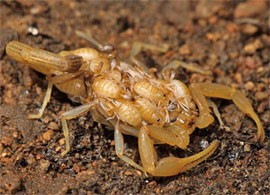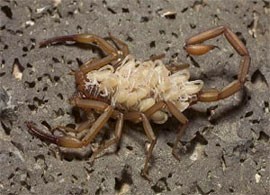The Five-striped Smooth-tail
Time to get busy! (Reproduction)
How does the Deathstalker scorpion reproduce?!
There are two main patterns in which scorpions will develop. One is the apoikogenic type and the other is the katoikogenic type (Warburg 2010). The Buthidae family of scorpions follows the apoikogenic type. This fancy term basically means that all of the embryo production will take place inside of the ovariuterus instead of outside of on a different structure (Warburg 2010).
The reproductive process of Leiurus quinquestriatus is a rather complicated process that involves many steps. It involves a unique movement called a “promenade à deux”, which is like a little dance the male and female scorpions do together.
In the reproduction process of the scorpions, the female is the sex in charge. Meaning, she decides if that particular male is the one! First off, molting must occur roughly 7 times before the female is capable of reproducing. The male scorpion must approach a female scorpion and grab her pedipalp chelae with his chelae fingers (Warburg and Elias 1998). Then a process that resembles a dance, the “promenade à deux”, takes place for a few minutes. After the dancing has ceased, the female decides if this is the male that she wants to mate with. If she agrees, the male will then eject a spermatophore (Abushama 1964). When this occurs he arranges the female into a position that exposes her genital aperture over the spermatophore. Once this position has been established the female takes up the sperm in to her ovariuterus to start reproduction of the embryos. The ovariuterus consists of three longitudinal tubes connected by four short tubes and like stated earlier, is the place where the embryo will be produced and continue to grow until it is mature and ready for delivery (Warburg 2010). After this reproductive process has finished, the male and female will separate (Dejours 1991).
Now it is time for the female to carry her young. The gestation period for a female scorpion varies from 122 to 227 days with the average being somewhere around 185 days. The female does not bury the eggs and wait for them to hatch. Instead, she harbors the eggs inside of her, in the ovariuterus and goes through what we would call a “live birth”. This means the young are delivered straight out of their mother, like how we deliver babies (Warburg and Elias 1998). The female can give birth to anywhere from 12 to 85 offspring with the average being around 62. An exact number is not known, because the number of offspring largely depends on the size of the mother (Dejours 1991). A larger mother scorpion would be capable of giving birth to more offspring than a mother scorpion of smaller size. The size of the mother, however, has no effect on the size of the offspring.
No studies have been done on the specific details of the parental behaviors of this scorpion species. However, it is known that the parental care is to be done by the females. Once the offspring are born, they crawl onto their mother’s back where they will remain as a group for a few weeks. Remaining on their mother’s back for a few weeks offers these offspring protection and it helps them to regulate moisture in these dry habitats (Dejours 1991). Before the young are able to get off of their mother’s back, they must molt. Typically they will molt multiple times, around 7, before they leave their mother (Abushama 1964). Once the young have been removed from the back of their mother, they are left to find food and a habitat for themselves. The Deathstalker scorpion has an extremely wide ranged lifespan. They can live to be anywhere from 4-25 years old, but an average age is not known (Abushama 1964).
Interested in learning about the interactions of the Deathstalker? Visit the Interactions Page. If not, feel free to head back Home.

